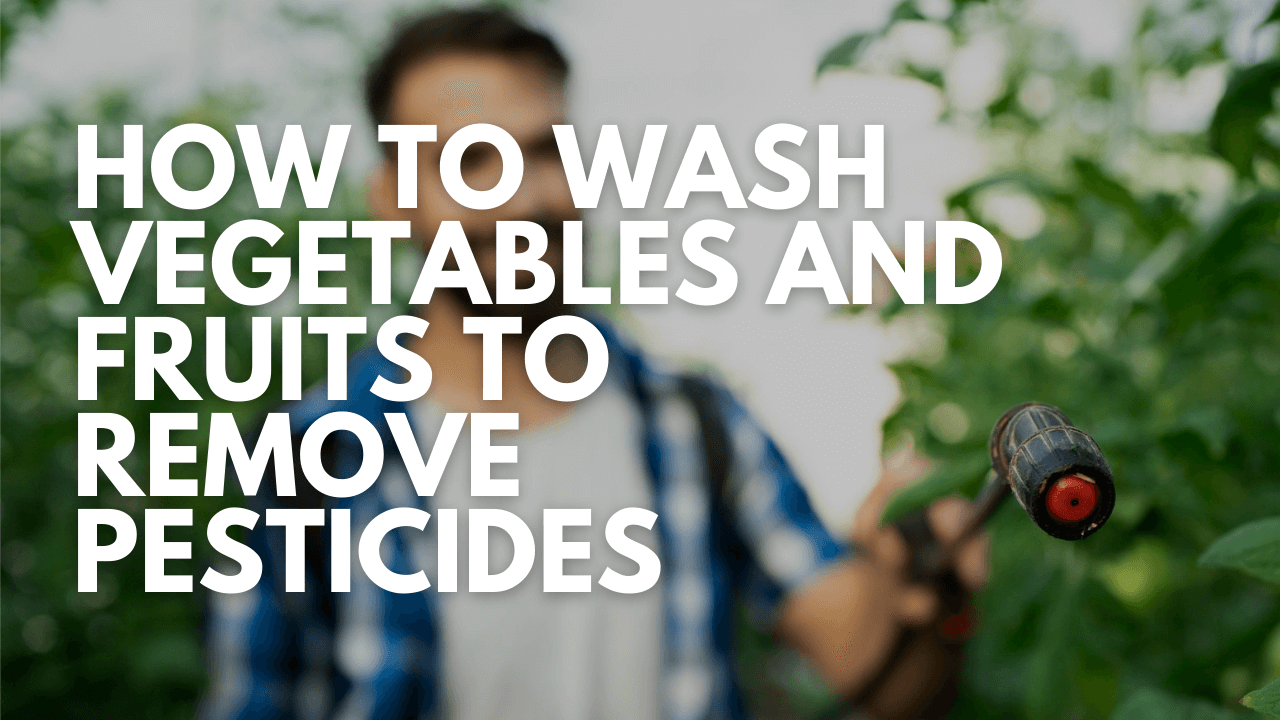We all know that getting our daily dose of fruit and veggies is one of the best things we can do for our health. They're a vital part of a good diet. The tricky part, though, is that many farms spray their crops with pesticides to keep insects from destroying them.
While these chemicals do a great job of protecting the food, they can leave behind residues that aren't so great for us. There are growing concerns that consuming pesticides might mess with our hormones, our endocrine system and our nervous system.
So, how can you make sure you’re not eating these unwanted chemicals along with your lunch? The easiest option is to go for organic produce whenever you can. But when that’s not on the cards, the next best thing is to give your fruits and vegetables a proper wash before you eat them. In this article, we'll discuss the best way to wash fruits and vegetables to remove pesticides.
Table of Contents
What's the Best Way to Avoid Consuming Pesticides?
Choosing organic food whenever you can is a great way to lower your exposure to things like synthetic pesticides, herbicides and chemical fertilisers. But if going fully organic isn’t always an option for you, don’t stress. You can still get rid of a lot of potential contaminants just by washing your produce the right way.
Giving your fruits and veggies a good, thorough rinse under cool, running water is a really important step. It helps to wash off any surface residues, dirt and microbes. For your firmer produce, such as potatoes, carrots, and apples, using a clean vegetable brush to give them a gentle scrub is an even better way to make sure they're clean, safe and ready to eat.

Best Ways to Wash Fruits and Vegetables to Remove Pesticides
Just giving your produce a quick rinse under the tap will get rid of some of the loose dirt and a few pesticides, but it really isn’t enough to do the job properly.
While studies have shown that most of those special fruit and veggie cleaners you see in the shops are no better than tap water, you can get a much better clean using a few things you’ve probably already got in your kitchen pantry.
The best ways to wash your produce involve a good soak in either saltwater, vinegar water or a baking soda solution.
Using Salt Water
A saltwater soak is one of the simplest and cheapest ways to help pull certain pesticides off your produce. The salt helps to draw contaminants away from the skin of the fruit or vegetable. In fact, scientific studies have found that a 10% saltwater solution can be quite effective.
Here’s how to do it:
Make the solution: Dissolve about two tablespoons of salt into a litre of warm water. Give it a good stir until the salt has completely dissolved, then let it cool down.
Soak your produce: Put your fruit or veggies into the saltwater bath and make sure they’re completely covered. Let them sit for about 10-15 minutes.
Give them a gentle scrub: For produce with thicker skin like apples, potatoes or cucumbers, a gentle scrub with a vegetable brush while they're in the water is a great idea. For more delicate things like berries or leafy greens, just swish them around gently.
Rinse well: After they've had their soak, rinse everything thoroughly under fresh, running water to get rid of any leftover salt and the pesticides you’ve just dislodged.

Using Vinegar Water
Another great method is a soak in diluted vinegar. The acidity of white vinegar is fantastic for breaking down surface pesticides, and it has the bonus of killing off many common bacteria and mould spores. You could use straight vinegar, but it’s expensive and can leave a really strong taste on your food. A diluted mix works wonders without the downside.
Here’s how to do it:
Prepare the bath: Mix up a solution of one part white vinegar to four parts water. So, for a big bowl or your kitchen sink, you could use one cup of vinegar and four cups of water.
Soak everything: Put your produce into the vinegar water and let it soak for about 15-20 minutes. You might notice a bit of a film floating on the surface – that’s a good sign it’s working!
Swish or scrub: Gently swish leafy greens like lettuce and spinach in the water. For anything with a firm skin, a light scrub with a vegetable brush works a treat.
Rinse thoroughly: Make sure you rinse the fruit and veggies properly under cool, running water to wash away any of that vinegar taste and smell.

Using Baking Soda
Research points to baking soda (or sodium bicarbonate) as being the champion for removing pesticides, not just from the surface, but from under the skin of produce too. One major study found that a simple baking soda solution was far more effective than tap water—and even a bleach solution—at cleaning pesticides off apples. It works by helping to break down the chemical structure of the pesticides. All it takes is a 12-15 minute soak to get rid of almost all the surface contaminants.
Here’s how to do it:
Fill your sink or a bowl: Fill a large bowl or a clean kitchen sink with water.
Add the baking soda: Add about one or two teaspoons of baking soda for every litre of water. Stir it around until it's all dissolved.
Soak your produce: Pop your fruit and veggies into the water, making sure they’re fully submerged. Let them soak for 12 to 15 minutes.
Scrub if you need to: After the soak, you can use a soft brush on firm produce like carrots or capsicums to get rid of any stubborn dirt.
Give it a final rinse: Lastly, rinse everything again under clean, running water to wash off the baking soda and the neutralised pesticides. For leafy greens like kale or lettuce, using a salad spinner after rinsing is a great way to get rid of excess water.

A High-Tech Helper: Ozone Water Purifiers
If you're looking for an even more powerful solution, an ozonator is something worth looking into. This is a device that creates ozone (O₃)—a strong, natural oxidising agent—and bubbles it through the water you're using to wash your food.
When ozone makes contact with contaminants like pesticides, bacteria and viruses, it quickly breaks them down into harmless stuff. It's incredibly effective for cleaning the surface of your produce.
The real challenge for any washing method is dealing with systemic pesticides—the ones that are absorbed right into the plant's tissue as it grows. While an ozone wash is a powerhouse for sanitising the surface, it can't reach deep into the flesh of the fruit. However, it can still help break down any systemic pesticides near the surface, doing a better job of reducing the overall chemical load than water alone.
The Most Important Final Step: Rinsing with Filtered Water
Imagine going to all that effort to clean your food, only to put contaminants back on during the final rinse. If you’re not using filtered water, your freshly cleaned fruit and veggies are being rinsed with whatever is in your tap water—that can include chlorine, heavy metals and even trace amounts of other pesticides.
Using filtered water for both cooking and rinsing your produce is one of the best things you can do. It means your body doesn't have to deal with detoxing all those extra contaminants.
Water Filters That Remove Pesticides
If you don't already have a water filter that can remove pesticides, it's a good idea to see what your options are. Activated carbon filtration systems are your best line of defence against pesticides and herbicides. A good quality carbon water filter can successfully remove over 95% of these chemicals from your water.
You can find effective carbon filters in benchtop, under sink or even whole-house systems. When you're on the hunt for a filter, keep an eye out for systems that use activated carbon or reverse osmosis technology.
Here are some of our top recommended water filters that offer the best way to wash your fruits and vegetables to remove pesticides effectively:
Feel free to take a look at our range of water filters designed specifically to remove pesticides. If you have any questions at all, please contact us. We’d be happy to help you find the right solution!
Effectively removing pesticides from produce is achievable with common household items. While rinsing with tap water is a good first step, soaking fruits and vegetables in a saltwater, diluted vinegar, or baking soda solution is far more effective at breaking down and removing chemical residues.
Research indicates that a baking soda solution is the most superior method for cleaning produce. A 12-15 minute soak can remove the vast majority of surface pesticides by breaking down their chemical structure.
The final step in washing your produce is crucial. Rinsing with filtered water is highly recommended to avoid re-contaminating your food with impurities often found in tap water, such as chlorine and heavy metals.
Hear from Our Satisfied Customers
What Is the Most Effective Way to Wash Produce?
According to scientific studies, soaking produce in a solution of baking soda and water for 12 to 15 minutes is the most effective method. This process helps to neutralise and remove pesticide residues not only from the surface but also from just under the skin.
How Should I Wash Delicate Items Like Berries or Leafy Greens?
For delicate produce like berries and leafy greens, vigorous scrubbing should be avoided. Instead, place them in a bowl with your chosen cleaning solution (e.g., baking soda and water), gently swish them around, and let them soak for the recommended time. Afterwards, rinse them carefully under cool, filtered water. A salad spinner can be useful for drying leafy greens.
Why Is It Important to Use Filtered Water for the Final Rinse?
Using unfiltered tap water for the final rinse can re-introduce contaminants like chlorine, heavy metals and trace amounts of other pesticides onto your freshly cleaned produce. Using filtered water ensures that your fruit and vegetables are as clean as possible before consumption.










